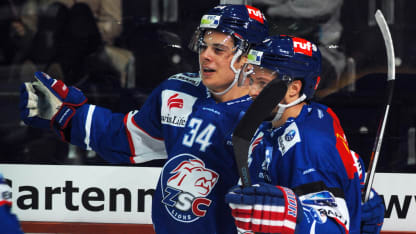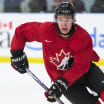The exceptions were Steven Stamkos of the Tampa Bay Lightning in 2008-09, and Nail Yakupov of the Edmonton Oilers in 2012-13, who averaged about 12:02 of ice time per game at even strength and were used primarily against secondary opponents.
Yakupov is a good example of the minimum expectations for Matthews. He was the only one with below-average possession numbers, who wasn't effective at drawing penalties, and who wasn't used in the shootout as a rookie. The other players were a combined 17 for 46 in the shootout in their first NHL seasons.
The only potential concerns are that none of the nine forwards were used to kill penalties and they weren't effective on faceoffs. As a group they won 43.9 percent of their faceoffs as rookies. The best was John Tavares of the New York Islanders, who won 47.5 percent in 2009-10.
Scoring-wise, their range extended from 0.58 points per game for Stamkos to 1.26 for Sidney Crosby of the Pittsburgh Penguins in 2005-06. Their average was 0.82 points per game, which works out to 67 points in an 82-game season.
In gauging whether these scoring expectations are realistic for Matthews, consider his performance this season with Zurich in National League A, Switzerland's top professional league, and how players have performed when moving directly from there to the NHL.
Very few players have gone from Switzerland to the NHL without spending at least one season in the American Hockey League. Since the 2004-05 NHL lockout, and setting aside those who played in Switzerland during the 2012-13 lockout, 13 players have gone from playing at least 20 games in the Swiss league to playing 20 NHL games the following season.
These 13 players had averaged 0.82 points per game in the Swiss league, then 0.32 in the NHL, which works out to a retention of 39 percent of their scoring. Based on his 46 points in 36 games this season, Matthews' NHL scoring expectation for next season would be closer to 40 points in 82 games, not 60.
The youngest and closest comparable player in that group coming from Switzerland is Damien Brunner, who at age 25 had 60 points in 45 games with Zug in Switzerland in 2011-12, followed by 26 points in 44 games with the Detroit Red Wings in the lockout-shortened, 48-game season in 2012-13. That projects to 44 points in 75 games for an 82-game season.
One of the key factors when comparing Brunner and Matthews is the age gap. It may have been more difficult for Matthews at age 18 to earn top-line ice time and generate scoring relative to an established veteran like Brunner.
That's why some teenage players exceed their scoring expectations in the NHL, such as Connor McDavid of the Edmonton Oilers, the first pick of the 2015 draft. McDavid had 48 points in 45 games this season, which is 25 percent more than what would have been expected based on his 120 points in 47 games last season with Erie Otters of the Ontario Hockey League, a league where players have retained 31.5 percent of their scoring. For that reason 60 points could be a target that's within reach for Matthews.
It's tough to project how well a young player will perform in his rookie NHL season because his performance can be influenced by so many factors outside his control, such as his health, his linemates, his opponents, his ice time in various man-power situations and his luck.
Nevertheless, the history of No. 1 draft picks suggests a 60-point season and quality time on the power play is a reasonable expectation for Matthews.


















